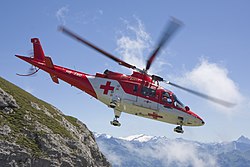Definitions
Rotor solidity is the ratio of area of the rotor blades to the area of the rotor disk. [2]
For a rotor with blades, each of radius and average chord , rotor solidity is:
where is the blade area and is the disk area.
For blades with a non-rectangular planform, solidity is often computed using an equivalent weighted form [3] as
where:
- is a weighting function corresponding to the blade section
- is solidity corresponding to the blade section
- is radial length to the blade section
The weighing function is determined by the aerodynamic performance parameter that is assumed to be constant in comparison to an equivalent rotor having a rectangular blade planform. For example, when rotor thrust coefficient is assumed to be constant, the weighing function comes out to be:
and the corresponding weighted solidity ratio is known as the thrust-weighted solidity ratio. [2] In dimensional form, [4] this is:
When rotor power or torque coefficient is assumed constant, the weighing function is:
and the corresponding weighted solidity ratio is known as the power or torque-weighted solidity ratio. This solidity ratio is analogous to the activity factor used in propeller design and is also used in wind turbine analysis. However, it is rarely used in helicopter design. [2]














